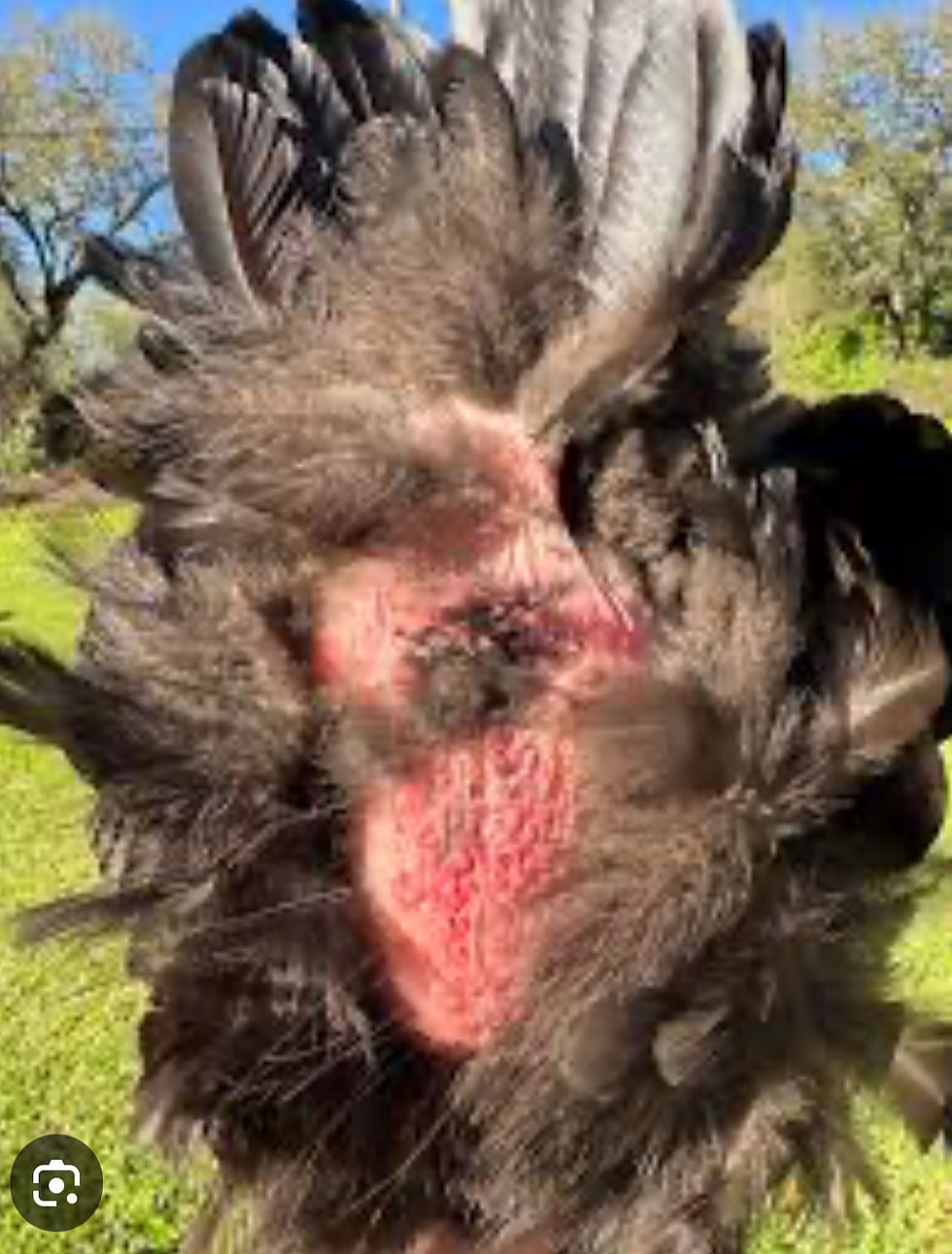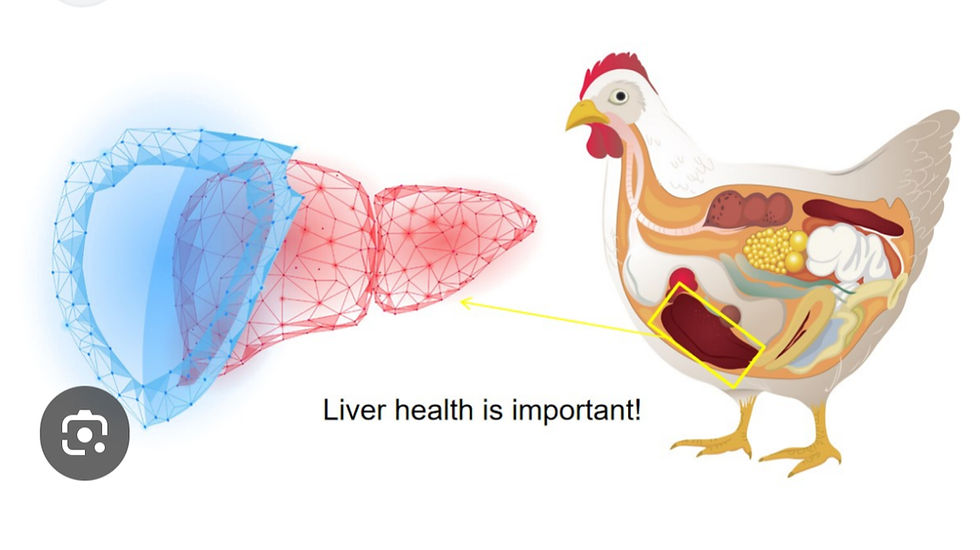Do Your Chickens Have Bald Spots? Understand the Causes!
- Donna Weekes

- Jul 27
- 7 min read
Updated: Sep 21

Many chicken owners often notice their hens developing bald spots-around the neck, breast, back or butt. While molting, pecking or parasites are usually the first suspects, one overlooked factor plays a huge role in feather regrowth: diet. If a laying hens nutritional needs aren't met, she may struggle to regrow feathers, leaving her with patchy or bald areas that never fully recover.
Feathers Require High-Quality Nutrition
Feathers are made of 85% protein (mainly keratin). For a hen to grow healthy, full plumage, she must have access to enough high-quality dietary protein. If her diet is lacking, the body prioritizes survival and egg production over feather regrowth. This means nutrition deficiencies can directly stall the feather replacement process.
Understanding Chicken Nutrition
To appreciate how nutrition affects feather health, it’s essential to grasp the basics of chicken nutrition. Chickens require a balanced diet that includes proteins, vitamins, minerals, and carbohydrates. They need enough amino acids, which are the building blocks of protein, along with vitamins A, D, and E, and essential minerals like calcium and phosphorus.
It's crucial for them to obtain the right amino acids, not just any protein, they need specific proteins tailored to their species, as not all proteins are the same.
If chickens do not receive these nutrients in the right balance, their feather health can suffer significantly. For example, feathers are primarily composed of keratin, and insufficient amino acids will result in weak feather structure, leading to noticeable bald spots. According to recent studies, a protein deficiency can reduce feather growth by up to 40%, impacting both appearance and overall health. These are visible issues, what about the ones you can see, their internal health.
The Impact of Protein (Amino Acid) Deficiency
An amino acid deficiency is a leading cause of feather loss in chickens. They need high-quality protein to support feather growth and maintenance. When feeding other things, it dilutes the complete balance they require, particularly in the diet of laying hens, bald patches can appear.
Common sources of amino acids is a typical layer feed that contains 16-18% protein.
To increase protein (amino acids) intake, switch over to a starter/grower feed which contains around 20% protein.
When molting season starts, which is mid to late summer/early Fall, the starter/grower feed is a great way to increase their protein intake, which is helpful in regrowing their feathers back more efficiently. Make sure you always offer a side dish of oyster shell for the hens still laying. Don't worry, they will regulate their own calcium intake and take it when they need it.
The Role of Vitamins and Minerals- Key Nutritional Factors in Feather Growth
Protein Deficiency
* Laying hens need around 16-18% protein in their feed. If they're eating too many scratch grains, kitchen scraps, mealworms or low-quality feed, they may not get enough amino acids (which are the building blocks of protein) to rebuild feathers.
* Methionine and cysteine, sulfur-containing amino acids, are especially critical for keratin production.
Calcium Prioritization
* Hens in lay require amounts of calcium for eggshell formation. If the diet is imbalanced-too much calcium without enough protein (amino acids)- the bird's body channels nutrients to egg production, not feather regrowth.
Vitamins & Minerals
* Zinc, manganese and biotin deficiencies are strongly linked to poor feather quality and bald spots.
* Lack of Vitamin A and E can slow tissue repair, meaning feathers struggle to emerge properly.
Energy Balance
* A hen that isn't eating enough calories may use dietary energy just to maintain body weight and keep laying. Feather production takes a back seat.
Key Amino Acids
Chickens cannot produce all the amino acids they need. Their diet must provide these "essential" amino acids for proper health and feather regrowth.
Methionine: Critical for growth, feather synthesis and overall protein synthesis.
Lysine: Vital for egg production and proper bone development.
Cystine: Works alongside methionine to help create the keratin needed for feather strength.
While protein is crucial, vitamins and minerals significantly contribute to feather health. Vitamin A, for example, is vital for skin health and feather regrowth. A study showed that chickens lacking adequate vitamin A experienced a 30% decrease in feather quality, leading to dry skin and increased feather breakage.
Calcium is another critical mineral, especially for laying hens, who need up to 4 grams a day for healthy egg production. Insufficient calcium not only leads to weak bones but also directly impacts feather quality and health. (Always have a separate dish of oyster shell available to your laying hens. They will regulate their own calcium intake and will take it when they need it.)
By neglecting the provision of a varied diet with enough vitamins and minerals, you risk not only bald spots but also broader health complications, such as reduced egg production and reproductive issues like obesity and prolapsed vent.
Why Bald Spots Persist
If the nutritional imbalance continues, hens may never fully replace missing feathers, even after molting. Over time this can leave them vulnerable to :
Skin damage from pecking or sunburn
Cold stress in cooler weather
Reduced protection against parasites
Preventing Bald Spots: The Balanced Diet Approach
To combat bald spots effectively, the first step is ensuring a balanced diet made to meet their nutritional needs. You can choose quality commercial feeds designed for your chickens.
Here are some actionable tips to ensure your chickens receive a balanced diet:
Choose High-Quality Feed: Select a commercial feed with high protein content (ideally above 16-18% for layers) and tailored for your chickens. During molting season, switch over to a starter/grower feed.
Avoid Excessive Treats and Extras: Providing extras and treats other than their chicken feed that comes in a pellet or crumble can disrupt the essential balance they need to stay healthy and regrow their feathers. Examples- fruits, vegetables, mealworms, scratch, cracked corn or anything else. It is of no benefit to them and is actually harming their health.
When giving treats and extras, even if they are healthy, it disrupts the nutritional balance provided by their chicken feed. Each bite of chicken feed is packed with 38 essential nutrients. If a chicken eats something else, that food doesn't contain the 38 nutrients needed in every bite to maintain a strong immune system, regrow feathers properly, lay eggs optimally, and ensure longevity. It all begins with their diet, which should primarily consist of their nutritionally complete chicken feed, with only 5-10% of their daily intake coming from extras and treats.
Making these dietary adjustments can not only reduce the risk of bald spots but also enhance the overall health and well-being of your flock.
Intestinal Parasites
If you practice both, a nutritionally complete chicken feed and do not feed extras, take a look at their gut health. Could they possibly have internal parasites?
How do chickens get worms?
Either a chicken eats infected droppings from another bird or the chicken eats an insect carrying worm eggs (earthworm, slug, snail, grasshopper, fly, etc.)
Untreated intestinal parasites can cause significant damage to a chickens intestinal wall, leading to reduced nutrient absorption, inflammation, bleeding and in severe cases, fatal complications like intestinal blockage.
Parasites can damage or destroy the villi, which are tiny finger-like projections in the intestinal lining responsible for nutrient absorption.
Untreated infections, especially from coccidia and roundworms, can cause inflammation and bleeding within the intestinal wall.
If left untreated, heavy infestations, particularly with roundworms can lead to a buildup of worms within the intestines, causing a physical blockage.
Just because you have not seen worms in their droppings does not mean they do not have worms. For roundworms, (which is the most common intestinal parasite) the prepatent period (time from ingestion of eggs to the presence of eggs or worms in droppings) can be around 28-30 days.
Worm Prevention/Control Best Practices
The best way to avoid having to concern yourself with a worm over-load is to keep the birds healthy; a healthy chicken can control a reasonable load of worms in its digestive tract.
Keeping the birds healthy means feeding them a nutritionally complete chicken feed only along with keeping feeders and waterers clean.
Molting
Molting can happen anytime after June 21st, the longest day of the year. After that, days will gradually get shorter. The shortened days trigger the hormones in chickens to start molting. Molting season can be from mid-summer to late Fall. If your chickens are molting in the first half of the year, as an example January-May, this is not typical molting and you need to look at other reasons for their missing feathers. Example would be diet or gut health.
You can support your chickens by adding vitamins to their diet to provide nutritional assistance during molting. We provide Chick' N Vitamins as an option.
Mites and Lice do not Cause Bald Spots-
No matter what you read or heard on social media, the only type of mite that can cause bald spots on chickens is the Depluming Mite, which is not very common in North America. Therefore, it's highly unlikely that your chickens have depluming mites.
Backyard chicken keepers often suspect mites because their chickens have bald patches or spots on their bodies and they are unsure of what else might be causing the problem.
More often than not, its usually diet related.
The two main reasons for bald spots in your chickens:
An unbalanced diet from feeding extras and treats.
Intestinal parasites
CHICK' N DIGESTION is a great preventative for parasites.
100% natural
Helps maintain healthy intestinal transit
Aids digestion and nutrient absorption
Positive effect on the immune system and intestinal microbiota
Directions for Use:
Dosage- 5 ml (1 teaspoon) per liter of fresh water
Preventively- 1-2 days a week
At the onset of signs of intestinal parasites- 3-5 days
PIPERAZINE DIHYDROCHLORIDE is a great treatment for roundworms.
One day treatment, repeat in 7-10 days. No egg withdrawal
Final Thoughts
Bald spots in hens aren't always caused by bullying or mites - sometimes, the problem is sitting right in the feeder or on the floor of the run, where you throw the treats. A poor diet, lacking in protein (amino acids) and key nutrients, can prevent feathers from growing back, leaving hens looking ragged and at risk. By fine-tuning nutrition you can support not only egg production but also the long-term health and feather condition of your flock.





Comments